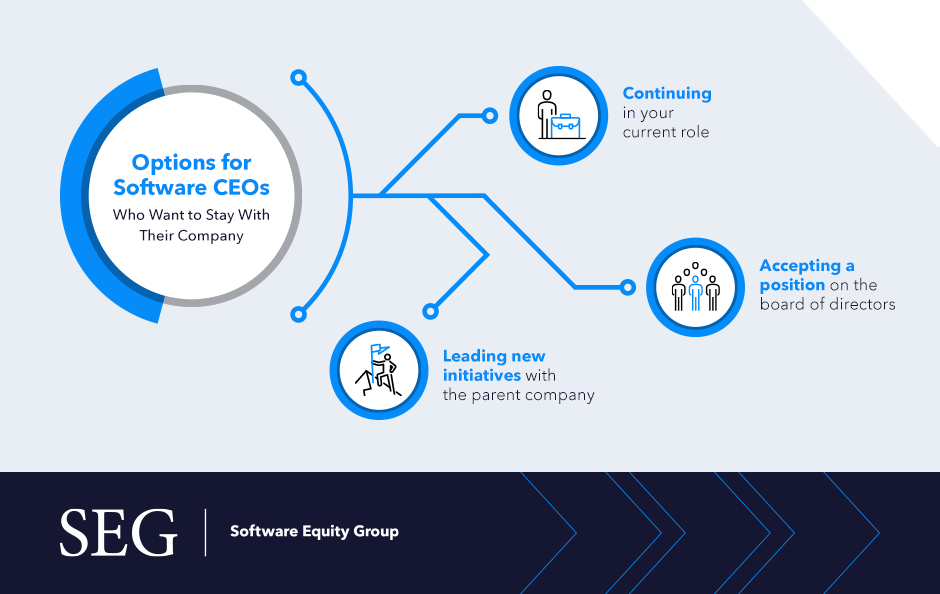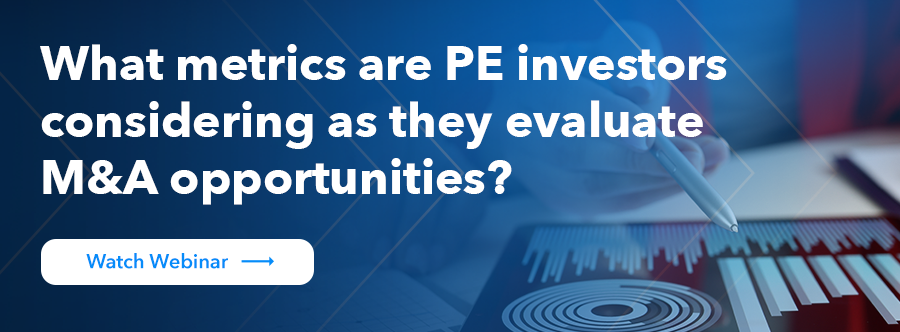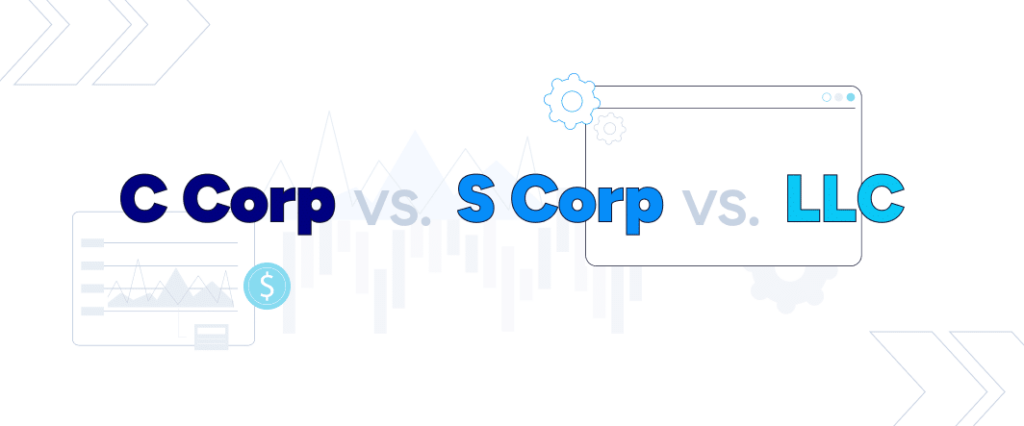Life After M&A: Five Scenarios Every Software CEO Should Consider

Do you have an exit strategy in place? The best time to begin planning for an exit is well before an offer comes in, but it can be hard to focus on planning for it when software CEOs and founders are in the process of building a great company.
While many software executives do think about an initial public offering (IPO), more than 97% of actual exits are through mergers and acquisitions. An M&A event offers different options for what life looks like after an exit, which vary based on several factors.
Let’s look at the five most common scenarios for software CEOs and founders after the deal closes and what outcomes happen with either a strategic buyer or a financial buyer. Understanding these options will help you be better prepared to develop your exit strategy.
- What Are the Options for Software CEOs Who Want to Exit?
- Scenario 1: Exit options with strategic buyers
- Scenario 2: Exit options with financial buyers
- What Are the Options for Software CEOs Who Want to Stay With Their Company?
- Scenario 3: Leading new initiatives with the parent company
- Scenario 4: Continuing in your current role
- Scenario 5: Accepting a position on the board of directors
- Advisors Can Help You Evaluate Offers Against Your Long-Term Goals
What Are the Options for Software CEOs Who Want to Exit?
First, let’s talk about outcomes after an acquisition for leaders who are ready to step away from the company. This option is on the table with either strategic or financial buyers and will help you evaluate offers from either type of buyer.
Scenario 1: Exit options with strategic buyers
If it is agreed that the seller will exit the business after being acquired, the strategic buyer will typically have resources to integrate and a plan in place. While many buyers may need you to stay on for a short period of time while the company is being integrated, they should have a straightforward plan on how long that will be and when you can expect to fully transition out.
Scenario 2: Exit options with financial buyers
While some financial buyers prefer the management team to stay on, others may be interested in installing their own leadership for your company. Because private equity (PE) investors may have other companies in your industry as part of their portfolio, they may have experienced leaders they’d like to tap to lead the company. These leaders often have experience rapidly scaling companies or could be industry veterans with connections and experience that will best guide your company into its next chapter.
Again, a clear transition plan will be an important part of any offer. Make sure the PE investors can offer you a timeframe on when you can expect to step away from the company.
What Are the Options for Software CEOs Who Want to Stay With Their Company?
You may think if you work with a strategic buyer it automatically means you need to exit, but that’s not true. If you decide to stay after the acquisition, there are a number of options for software CEOs to integrate with the new company. This may mean leading new initiatives or taking on a new role within the acquired company or with the parent company. Or, other software CEOs step into advisory roles that focus on high-level decisions for the company.
What do you envision for your future role? Let’s look at these common scenarios in more detail so you can decide what will be the right move for you.

Scenario 3: Leading new initiatives with the parent company
Depending on the type of buyer, a new role at the parent company can look very different. This can include an expansion of your role with broad responsibilities at a larger organization or taking on a new initiative within the company being acquired or the parent company. With strategic and PE-backed strategic buyers, they may offer you leadership positions within the parent company.
Strategic or PE-backed strategic buyers are the best fit for software CEO who want to take this path. Taking on a new role or leading new initiatives through a strategic purchase will offer you the opportunity to become part of a bigger brand within your industry, enabling you to share your market expertise, drive product enhancements, and support expansion opportunities. And strategic buyers will have capital in place to support product leadership and expansion opportunities.
For software CEOs, these deals to stay on with the new company often present an upside. This can include stock in the parent company and new and exciting opportunities for your leadership path.
Specifically for PE-backed strategic acquisitions, taking on a new role within the PE’s portfolio company will benefit your employees because the infusion of capital focused on growth will help them advance in roles more quickly than they normally would have. You will now be working with a company with private equity backing earmarked for growth.
Scenario 4: Continuing in your current role
You might have heard the saying “good companies get bought, not sold.” If you’ve built a good company, getting purchased by a private equity buyer gives you the capital and resources you need to really make an impact in your market.
This is one scenario when you are acquired by PE investors. They’re looking for a return on their investment and may not want to make changes when you’ve got a good thing going. The infusion of capital can help scale your company. Software CEOs and founders can also roll equity, continuing in their same role of leading the company’s vision, strategy, and execution and getting a second bite of the apple later down the road when the PE investor sells the company.
Scenario 5: Accepting a position on the board of directors
Another option for leaders that want to stay involved after an acquisition is stepping into a board member role. This will mostly happen with PE buyers who will then bring in a new management team to lead the day-to-day operations of your company.
This is a great option for entrepreneurs who want to keep some skin in the game with their company while moving into a more strategic role. This option can provide additional financial options that can really benefit entrepreneurs. Software CEOs who take this path roll a minority of their equity into the post-deal structure and then receive additional liquidity when the company sells again will get a ‘second bite of the apple’. This strategy benefits the company because it provides additional liquidity upfront, and software CEOs will often receive as much or more on their second bite.
As we mentioned above, your company will benefit from an infusion of capital. Employees in a growth-stage start-up have likely had to deal with small budgets and an intense product focus for the company. Now, with the additional capital, employees will see the benefits from investments in sales and marketing, along with the expertise from PE investors who have worked with other companies in the industry. Employees will have the opportunity to get a broader range of feedback on ideas and see more growth opportunities.
Advisors Can Help You Evaluate Offers Against Your Long-Term Goals
When you envision your company and your life after an acquisition, what do you see? While any option we’ve talked about here is a good one for you, understanding what you’d like your future role to be will help you in evaluating offers, types of buyers, and corporate culture if you decide you’d like to stay on after the sale.
It’s likely you haven’t sold a company before, and even if you have, every deal is unique. As you consider what you want your future to be after a sale, begin looking at who can advise you through the process. An advisor will be able to help you define your exit strategy and evaluate offers against it.
Advisors can help you see a deal from every side and help you understand the best approach to take to meet your goals for the period of time after the acquisition. An advisor can detail what to expect during and after the deal, helping you set up a clear plan and expectations so you won’t be living with regrets about what could have been after the sale.










